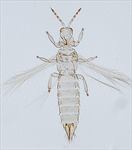
Female - pale form
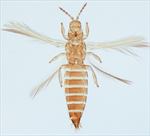
Female - dark form

Antenna
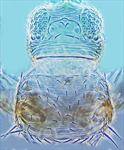
Head & pronotum
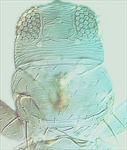
Head & pronotum

Head & thoracic tergites
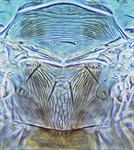
Mesonotum & metanotum
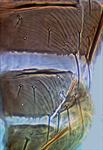
Tergites VII–VIII

Abdominal pleurotergites IV–VI
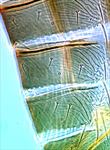
Tergites VI–VIII, lateral

Sternites V–VII

Male sternites

Male tergites VII–IX

Fore wing
Both sexes fully winged. Body varying greatly in color from yellow to brown, legs yellowish; antennal segments I–III yellow, also base of IV; fore wing pale. Antennae 7-segmented; III–IV each with a short forked sense cone; segment VII short. Head wider than long; two pairs of ocellar setae; pair III small and arising just within ocellar triangle, posterolateral to fore ocellus; postocular setae pair I about as long as ocellar setae pair III, pairs II & III subequal. Pronotum with 2 pairs of prominent posteroangular setae; 4–5 pairs of posteromarginal setae. Metanotum reticulate medially, reticles elongate near posterior but equiangular just posterior to setae; median setae arising behind anterior margin; campaniform sensilla present. Fore wing first vein with 3 setae on distal half; second vein with about 18 setae; clavus with 5 marginal setae. Abdominal tergite II with 3 lateral marginal setae; tergites V–VIII with ctenidia present laterally, on VIII posteromesad to spiracles; tergite VIII posteromarginal comb absent medially, represented by a few irregular microtrichia laterally; pleurotergites with 1–3 discal setae. Sternite II with 2 pairs of marginal setae, III–V & VII usually with 3 pairs, VI commonly with 4 or 5 pairs; sternite II with 1–4 discal setae, III–VII with 12–24 discal setae in more than one irregular transverse row.
Male smaller than female; tergite VIII with no marginal comb; sternites III–VII with slender transverse pore plate anterior to row of discal setae.
T. imaginis has not been found in California, but is included here because of its potential for invading the USA. A closely related, but consistently pale-bodied, species from northern Australia, T. safrus Mound & Masumoto, is recorded from Hawaii, but that has no pleurotergal discal setae. These two species are unusual within the genus Thrips because of the large number of discal setae on the abdominal sternites. The genus Thrips is the second largest genus in the Thysanoptera, and currently includes, worldwide, about 295 species. All members of this genus lack ocellar setae I on the head, and they all have ctenidia on tergite VIII posteromesad to the spiracles. Other characters, such as number of antennal segments, number of setae on the fore wing veins, and number of discal setae on the sternites are variable between species (Palmer, 1992; Mound & Masumoto, 2005).
Highly polyphagous, and breeding in the flowers of many unrelated native and introduced plant species in Australia. It was at one time considered a pest of pome fruits, and large populations sometimes reduce fruit set on grape vines.
Widespread across southern Australia; introduced to New Zealand and New Caledonia, and taken in quarantine in the Netherlands. [not recorded from California, but see Mound et al., 2017].
THRIPIDAE - THRIPINAE
Thrips imaginis Bagnall
Thrips imaginis Bagnall, 1926: 111
Thrips fortis Bagnall, 1926: 109
Thrips apicalis Bagnall, 1926: 111
Neophysopus io Girault, 1927: 1
Thrips shakespearei Girault, 1927: 1
Neophysopus aureolus Girault, 1928: 3
Aptinothrips apertus Kelly & Mayne, 1934: 33.
Mound LA & Masumoto M (2005) The genus Thrips (Thysanoptera, Thripidae) in Australia, New Caledonia and New Zealand. Zootaxa 1020: 1–64.
Mound LA, Matsunaga J, Bushe B, Hoddle MS & Wells A (2017) Adventive Thysanoptera Species on the Hawaiian Islands: New Records and Putative Host Associations. Proceedings of the Hawaiian Entomological Society 49: 17–28.
Nakahara S (1994) The genus Thrips Linnaeus (Thysanoptera: Thripidae) of the New World. United States Department of Agriculture. Technical Bulletin 1822: 1–183.
Palmer JM (1992) Thrips (Thysanoptera) from Pakistan to the Pacific: a review. Bulletin of the British Museum (Natural History) Entomology Series 61 (1): 1–76.